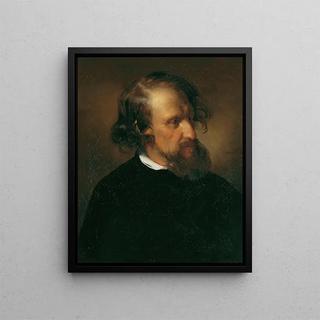Art print of the painter and lithographer Josef Kriehuber 1800-1876 - Friedrich von Amerling


View from behind

Frame (optional)
In the rich and captivating universe of art, certain works stand out for their ability to capture the essence of an era while offering a penetrating insight into the human psyche. The art print of the painter and lithographer Josef Kriehuber 1800-1876 - Friedrich von Amerling is a perfect example. This piece does not merely depict an artist; it evokes a pivotal period of the 19th century, where art and the science of lithography intertwined to give birth to new forms of expression. Through this work, artist Friedrich von Amerling invites us to explore the subtleties of artistic creation while paying homage to his predecessor, Josef Kriehuber, whose portraits marked his time.
Style and uniqueness of the work
The art print of this piece is distinguished by its elegance and finesse. Amerling, with his inimitable style, manages to convey not only Kriehuber's physical appearance but also a certain psychological depth. The meticulous details of the face, the play of light and shadow, as well as the harmonious composition, testify to rare technical mastery. The artist creates a dialogue between the subject and the viewer, inviting this latter to reflect on Kriehuber's life and work. Each brushstroke seems charged with meaning, revealing not only the personality of the artist but also the artistic and cultural context of his time. Amerling does not limit himself to a simple portrait; he offers a true immersion into the world of lithography, a technique that, at the time, was undergoing significant evolution.
The artist and his influence
Friedrich von Amerling, an emblematic figure of the Austrian art world, managed to build a solid reputation thanks to his exceptional talent. Born in 1803, he was influenced by the great masters of his time, while developing a personal style that is uniquely his own. His fascination with lithography and his commitment to capturing human beauty made him an essential artist. In paying homage to Josef Kriehuber, Amerling emphasizes the importance of the latter in the development of lithography as a full-fledged art form. Kriehuber,

Matte finish

View from behind

Frame (optional)
In the rich and captivating universe of art, certain works stand out for their ability to capture the essence of an era while offering a penetrating insight into the human psyche. The art print of the painter and lithographer Josef Kriehuber 1800-1876 - Friedrich von Amerling is a perfect example. This piece does not merely depict an artist; it evokes a pivotal period of the 19th century, where art and the science of lithography intertwined to give birth to new forms of expression. Through this work, artist Friedrich von Amerling invites us to explore the subtleties of artistic creation while paying homage to his predecessor, Josef Kriehuber, whose portraits marked his time.
Style and uniqueness of the work
The art print of this piece is distinguished by its elegance and finesse. Amerling, with his inimitable style, manages to convey not only Kriehuber's physical appearance but also a certain psychological depth. The meticulous details of the face, the play of light and shadow, as well as the harmonious composition, testify to rare technical mastery. The artist creates a dialogue between the subject and the viewer, inviting this latter to reflect on Kriehuber's life and work. Each brushstroke seems charged with meaning, revealing not only the personality of the artist but also the artistic and cultural context of his time. Amerling does not limit himself to a simple portrait; he offers a true immersion into the world of lithography, a technique that, at the time, was undergoing significant evolution.
The artist and his influence
Friedrich von Amerling, an emblematic figure of the Austrian art world, managed to build a solid reputation thanks to his exceptional talent. Born in 1803, he was influenced by the great masters of his time, while developing a personal style that is uniquely his own. His fascination with lithography and his commitment to capturing human beauty made him an essential artist. In paying homage to Josef Kriehuber, Amerling emphasizes the importance of the latter in the development of lithography as a full-fledged art form. Kriehuber,
12,34 €






